Future's Past: Ratchet & Clank and the Problem of Sequels
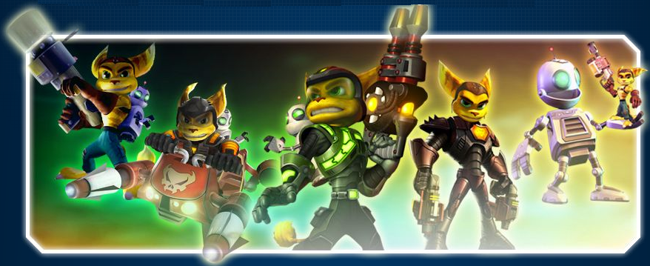
Insomniac’s Ratchet and Clank have come a long way. Seven years after their first outing in late 2002, Ratchet & Clank Future: A Crack In Time marks the ninth installment of a franchise spanning three platforms. (Tenth and four if you count the oft-forgotten Ratchet & Clank: Going Mobile.) They’ve even got action figures now.
A Crack In Time is easily the best Ratchet & Clank game on the PS3, and will be many fans' favorite of the whole series. It certainly does have several series bests: the best writing, the best humor, the best Clank gameplay, the return of the series’s best villain, and the single most fascinating and complex character ever to grace a Ratchet & Clank game.
But to understand A Crack In Time’s greatest triumph, what it accomplishes that none of its predecessors do, we have to look back through the evolutionary paths traced by the series.
The original Ratchet & Clank establishes the series formula, but it’s important to realize that in 2002, this game actually shook up the then-dominant platformer genre. Ratchet & Clank isn’t just about making difficult jumps along the way from point A to B. Its varied gameplay includes ship and mech combat, races and rail-grinding, a few types of puzzles, and above all else, shooting. The franchise’s trademark has always been its quirky arsenal of ludicrous and deadly weapons.
Ratchet & Clank: Going Commando runs with the success of its predecessor, expanding in virtually every direction. It adds an arena, new gadgets and armor, deeper ship and mech combat, and more complex puzzles. Most notably, the weapon stockpile increases from the original’s fifteen to a whopping twenty-four that gain experience and level up through use (a feature carried forward throughout the series). This sequel takes everything that defines the niche carved out by the original, and pushes it farther.
The third game, Ratchet & Clank: Up Your Arsenal, takes the growth of the series thus far and refines it, trimming the fat while strengthening the core. Weapon count is reduced to twenty, but the new set is much better balanced with less redundancy. Ship combat is gone and mech combat minimized, but the arena is fleshed out to include platforming challenges as well as fighting. There are also dropship missions - some levels include a “Galactic Rangers” dropship Ratchet can board to aid the Rangers in an optional, combat-oriented mission campaign, commonly featuring capture-the-flag or king-of-the-hill gameplay. And - my personal favorite - the game-within-a-game Captain Qwark “vid-comic” sidescrollers.
Everything in Up Your Arsenal is fun and well-tuned. But it is obvious that some of the platformer elements of its predecessors are de-emphasized, if not outright missing. And then comes Ratchet: Deadlocked.
By the time of Deadlocked, Ratchet and Clank have starred in three acclaimed adventures, each better received than the last. What started as a genre-bending formula-shaker has itself become formulaic. So it’s not surprising that Insomniac starts shaking up its own formula.
Even the title makes clear that things are different this time around - there is no Clank in there! (Except in the Japanese release, but cultural differences have meant Ratchet has always been marketed a bit differently there than the rest of the world.) The reason is that unlike the previous games, where Ratchet runs around with Clank on his back, and Clank occasionally goes off on a level of his own, Clank is nowhere near Deadlocked’s gameplay. Instead, two combat bots follow Ratchet around and take over most of the puzzle-based minigame activities (hacking, repairing, unlocking). They even shoot at enemies, though their guns don’t do anywhere near as much damage as Ratchet’s. The game’s cover, too, makes it clear the game is darker and grittier than earlier installments (again, except for Japan’s). Even Ratchet’s physical proportions are more adult, and less cartoonish.
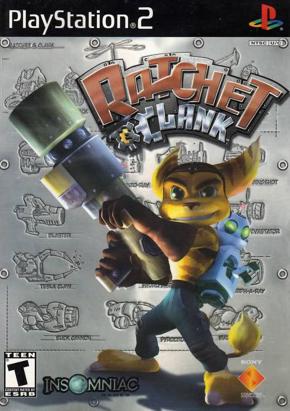
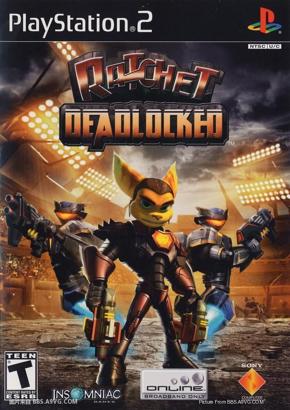
The reviews agree - Deadlocked is a shooter with platformer elements, not a platformer with guns. But in truth, Deadlocked is not the radical departure one might expect it to be - it is merely the logical continuation of the franchise’s evolution thus far, combined with the willingness to shed even highly iconic elements that the series has outgrown.
The weapon count is pared down to ten, the smallest arsenal yet - but it is a perfectly balanced set free of redundancy, and discontinued weapon archetypes live on in the new mod system in a way that keeps the other weapons fresh. Planets, rather than being explored, present campaigns of discrete missions - a natural expansion of the design philosophy of the arena and dropships. Skill points, which have never given any hint on how they might be obtained, are explicitly spelled out - saving the player the trip to GameFAQs but not making them any less challenging to actually pull off. The strafing-based control scheme presented as optional in Up Your Arsenal is now the default - and if stuck with for the half-hour or so it takes to adjust, reveals itself as a much tighter match to the gameplay. Everything about the game says, “I know this is different from what you remember - but if you give it a chance, you’ll like it.”
Deadlocked is still favorably received, but it earns lower scores than any of its predecessors.
“Ratchet: Deadlocked feels off-kilter in part because Insomniac has vastly reduced Clank’s presence. Instead of providing commentary from Ratchet’s backpack, he now chimes in from a remote space station now and then to make somewhat disembodied suggestions. Fans of the series won’t help feeling that something is missing."
—Jane Pinckard, Ratchet: Deadlocked Review
Insomniac takes a break from the series, and 2006 is the first (and so far, only) year since the franchise’s inception in which no Ratchet & Clank game is released. It isn’t even Insomniac that puts out the next one, but High Impact, a studio spun-off from Insomniac to develop for the PSP.

All in all, Size Matters is a giant step backward for the series. It does bring a few innovations of its own (most notably, the armor set system) but it plays like an averaging of the early games, rather than anything new. In the attempt to assuage the fans, it brings back everything that Deadlocked had been right to eliminate.
This is made clear by a bizarrely illuminating point in the Dayni Moon level of Size Matters. Using Clank’s Heli-Pack, Ratchet must glide from a high platform to a distant and lower plateau to continue in the level. It takes a long time, and he must glide the whole way - if the player releases the glide button and simply falls, Ratchet will miss the plateau and plummet to his death. It’s an incredibly dull moment, and it perfectly illustrates why Deadlocked removed Clank: he slows the game down.
When Clank acquires the Heli-Pack partway through the first game, it is nifty and new and allows Ratchet to access new areas. But the novelty wears off in subsequent games. Gliding simply becomes a slow, uninteresting way to travel. When they finally take Clank away from Ratchet in Deadlocked, he is suddenly unable to glide for the first time in years. It’s disorienting, and makes the player feel naked. But in terms of gameplay, it means tighter levels. It means not sitting there holding the glide button and waiting, waiting, waiting to reach the destination.
But all fans see is that their beloved robot buddy has been relegated to the sidelines. They are angered, and the franchise has to spend its next two games mollifying them. (Size Matters even goes so far as to actually rip on Deadlocked: Ratchet explains to Clank that the reason he is able to so easily dispatch dozens of evil clones of himself is because “I’m not half as good without you.” Clank replies, “True.” It would be cute if it were not for the obnoxious undertone.)
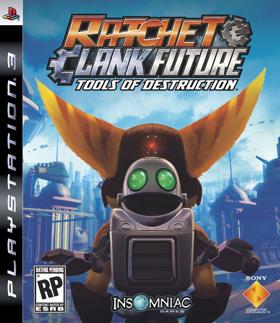
“Building on the bright and breezy world you’ve already seen in the trailer for Ratchet and Clank Future: Tools of Destruction, new screenshots have been released for their first foray onto the PS3, and it looks absolutely gorgeous.
Equally stunning is the confirmation from developer Insomniac that the series will move away from Ratchet’s aggressive, combat orientated exploits in Up Your Arsenal and Gladiator to return to its platforming roots."
—Kev Lochun, PS3 Ratchet: It’s not all about guns
(Gladiator is the European title for Deadlocked.)
Tools of Destruction plays like a bigger, brighter pre-Deadlocked game - again, with Clank on Ratchet’s back (the cover is even a close-up of Clank on Ratchet’s back) exploring planets, though at least this time the arena returns, albeit smaller than before and without the platforming challenges. The game tries a few experiments of its own, which largely fall flat - a few elements involve Sixaxis motion control, and “devices” are introduced alongside the gadgets and weapons, though since they do not gain experience there is little reason to use them instead of the weapons.
The fans, apparently, are mollified, and the two “back to the roots” titles both score higher than Deadlocked. But it is hard not to notice that the franchise is playing very close to formula.
“A warm plate of comfort food in electronic format, Insomniac’s Ratchet & Clank Future: Tools of Destruction makes its debut on PS3 to establish a foothold in the action-platformer genre while rounding out the shiny machine’s unimpressive software selection. It’s a welcome entry, but at this point I’d be willing to bet most players know what to expect from it. The territory covered here is well-worn and will hold little surprise for anyone who’s played any of the other entries in the series. That’s not to say it’s bad; it can still be quite enjoyable to take a few starchy bites of something so comfortable and familiar. On the other hand, an argument can easily be made that Insomniac has played it too safe with the ingredients in the recipe. Anyone hoping that cooking things up on a new platform would add unexpected, exotic flavors will likely come away feeling slightly unsatisfied. Like a box of Kraft macaroni & cheese, it may be absolutely competent, but it’s hardly inspired."
—Brad Gallaway, Ratchet & Clank Future: Tools of Destruction – Review
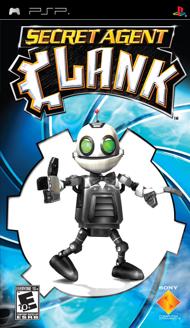
The game’s reception is a new low point for the series, scoring worse than even Deadlocked.
“Secret Agent Clank is going to get a bad rap because the changes in gameplay, especially with the lack of it really being stealthy, simply will not be enough to satisfy hardcore Ratchet fans, even if it is supposed to be just a Clank standalone."
—Danreb Victorio, Secret Agent Clank Game Review
Shortly afterward, Insomniac puts out its next PS3 installment - the downloadable Ratchet & Clank Future: Quest for Booty. A shorter, budget-priced adventure, Quest for Booty is positioned as a bite-sized “entry point” for players new to the franchise. While it adds a few new tricks emphasizing the puzzle elements of the platforming (notably the kinetic tether that allows Ratchet to manipulate certain objects from a distance and the light/dark gameplay of the heliogrubs), it removes many traditional gameplay elements. Weapons are not bought, but simply provided to Ratchet as he reaches certain points in the game’s plot. It’s impossible to backtrack to previous areas, and there is no Challenge Mode, which has been in every single other game in the franchise. Unlike Deadlocked’s streamlining, Quest for Booty’s omissions seem to be part of an attempt to simplify things for new players.
Its reception is better than that of Secret Agent Clank, but its scores are lower than any other Ratchet & Clank game to date.
“Just to be very clear: I don’t care about the price — I’ll pay $15 for a few hours of Ratchet every time. That said, I would’ve ultimately preferred something a little different for the download space — the high production values go a long way toward legitimizing PSN as a delivery medium, but I can’t help but wish for something more along the lines of the side-scrolling Capt. Qwark levels from Up Your Arsenal. Quest for Booty’s a fine addition to the Ratchet & Clank world, but what should’ve been a love letter to fans ends up serving better as a taste of what outsiders are missing — and, as a fan, that makes me just a little bit sad."
—Nick Suttner, Ratchet & Clank: Quest for Booty Review
Every single time Ratchet & Clank steps away from formula, they are punished for it. So when Insomniac wraps up the Future trilogy on the PS3 with A Crack In Time, what do they do?
To answer that question, let’s consider an illustrative example: the wrench.
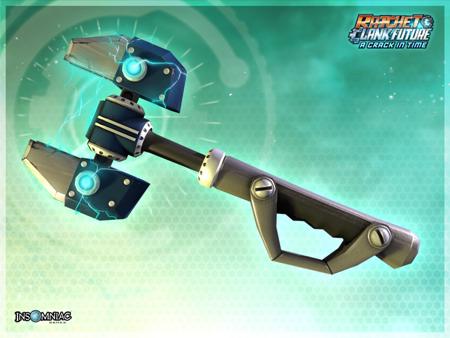
Ratchet & Clank games have always been known for their outlandish weapons, but the single most iconic one, the only one to appear in every single game, the only one Ratchet is never without, is the simple wrench. It even has its own dedicated button - while the other weapons have to share Circle, the wrench gets Square all to itself.
In the first game, the wrench is a perfectly viable weapon. Its limited range is offset by its lack of need for ammo, as well as its fairly high damage output and fast attack speed. A skilled player can get through most of the game without using any guns. The wrench is also occasionally used outside of combat, to turn bolt cranks to unlock doors or extend bridges.
In Going Commando, gameplay is clearly designed with guns in mind. Leaning on the wrench will lead rapidly to frustration, as enemies are far more effective at longer ranges, and the wrench’s damage is quickly outclassed by the other weapons. The wrench is still there for the bolt cranks or in case Ratchet runs out of ammo, but there is much less call to use it. The same is true in Up Your Arsenal, but by this time it was becoming obvious that even the bolt cranks were a bit silly. They had started as new and interesting, but as the novelty wore off they were revealed as busy-work. In Deadlocked, Ratchet doesn’t even need to turn bolt cranks himself: he can instead order one of his combat bots to do it, and then guard the bot from attack until the crank is turned. The busy-work is replaced with combat. But now there is even less reason for the wrench to be so prominent.
Like Deadlocked’s other steps away from established formula, this change is rolled back by subsequent games and the wrench’s role is again tied mainly to the artificial importance of the bolt crank. High Impact’s games, Size Matters and Secret Agent Clank, both give the wrench extra combat abilities, but there’s still little reason to fight with the wrench when there are weapons to be leveled. Quest for Booty adds the kinetic tether and heliogrubs as mentioned before, both of which use the wrench but in fairly uninteresting ways.
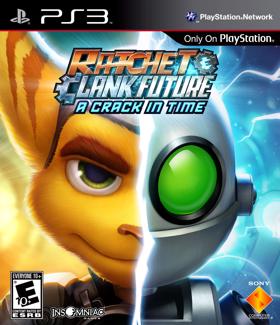
In A Crack In Time, Zoni serve as a new kind of collectible, often found in hard-to-reach locations or needing to be chased. Insomniac could allow Ratchet to collect them merely by walking over them, as they’ve always done with other collectibles such as gold bolts. They don’t. The Zoni can only be picked up with the wrench, requiring the player to press a button. It’s more engaging, giving the player a solid “Gotcha!” moment. But it’s also another justification for the wrench’s presence.
And this reflects the fundamental difference between Deadlocked’s and A Crack In Time’s approach: when aspects of the series formula showed age, Deadlocked abandoned them as unneeded. A Crack In Time freshened them up, justifying them and making them fun again. Deadlocked’s approach may foster more innovation, but it’s not hard to see why fans would prefer that used by A Crack In Time.
The greatest triumph of A Crack In Time is that it finds a way to handle the growing staleness of the formula without alienating anyone. It takes the series’s iconic features, the things fans expect to see, and improves them.
“But really, just about everything in A Crack in Time is done very well — aside from the fact that it’s all been done very well before.
And that’s the thing… if you’ve really gotten your fill with either Tools or Booty, I’ll admit that there might not be enough to tempt you here. But know this: I’m a casual fan of the series and I still found myself excited to get home and play the game each night the past week. It may be a lot of more of the same, but more of the same has never been so darn addicting."
—Sam Kennedy, Ratchet & Clank Future A Crack in Time Review
An installed fanbase is a double-edged sword. By having Ratchet’s name on it, Deadlocked surely got more attention than a new IP would have. But that new IP wouldn’t have attracted complaints that the protagonist didn’t have a robot on his back and didn’t spend enough time with puzzle minigames. A Crack In Time managed to improve the formula - but to keep fans happy, it was still constrained by that formula. The balancing act between innovation and nostalgia can be very limiting.
“Fans create sequels that hold up the predecessors as something to live up to, rather than something to improve upon. And that’s not the right mindset to take. If you’re not going to try to be better, what’s the point? To give something to all the other fans? They won’t appreciate it. The more fan-oriented an installment becomes, the more holes they find to pick in it. Some kind of Un-fan-ny Valley effect, perhaps. But give it to someone who isn’t a fan and they’ll force it to change, and evolve. The fans will like it even less, but frankly, fuck ‘em."
—Ben “Yahtzee” Croshaw, Extra Punctuation: On Sequels
Insomniac has said that A Crack In Time may be the last Ratchet & Clank. The franchise could not ask for a more fitting finale. A Crack In Time is the pinnacle of the beloved formula. Perhaps it’s time for a new one.